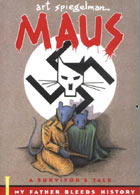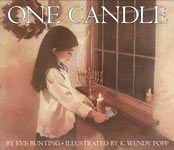The Holocaust through Kids' Books
We promised quite some time ago that we would do a newsletter on the subject of the Holocaust. It's time to fulfill that promise.
First of all, a caution: Be aware that reading, investigating and talking about the Holocaust may be the first up-close personal and explicit encounter your students may have had with man's inhumanity to man. The horror is such that some may need professional help after or during this time. Get some resources lined up before you begin.

There are many excellent resources online and in print for teachers. One of the best is the site maintained by the Holocaust Museum:
http://www.ushmm.org/education/foreducators/
They offer an online teacher workshop offering good support information on teaching the Holocaust. An excellent guide Teaching the Holocaust is available there for free download. There are other such guides available, many of which are very good indeed. There's no need for us to attempt to create another one. It seems to us that the best help we can offer is an annotated listing of some good books.
This list is by no means complete. We've listed just some of the many books for young people on the subject of the Holocaust, both fiction and nonfiction as well as picture books. It's quite possible to have each student reading a different book. The information they gain should be wide-ranging. This is a good chance to compare the genres and evaluate the information each has to offer. Discussions and investigation resulting from these books is where a great deal of the learning will take place.
Usually, we start a theme with a picture book, but in this case, although there are good picture books on the Holocaust, most of them are better appreciated with a little background knowledge. However, don't forget the picture books and don't assume that they are for very young children. Given the subject, that is certainly not true.
The books and the approach you use will depend on the age of the students. For those in 8th and 9th grade, I'd start with Maus: A Survivor's Tale by Art Spiegeman (Order Info.). Don't let the comic book format fool you, this is not easy reading. It's an allegory in which Jews are mice; the Germans are cats. These and other animals tell the story of Spiegelman's father, a concentration camp survivor. The skill of the artist is such that the device of dehumanizing the characters does not create emotional distance. Because of its format, you can't read it aloud. Get multiple copies. There are two volumes.

For slightly younger students, sixth or seventh graders, the best approach might be through Jane Yolen's The Devil's Arithmetic (Order Info.). This can be read aloud. The protagonist, Hannah, resents her family's preoccupation with the past and the Holocaust some of them survived. When selected to be the one to open the door for the prophet Elijah at the Seder, Hannah steps into the world of 1940s Poland. The concentration camp awaits.
Still younger students, fourth and fifth graders, might approach the study through Number the Stars by Lois Lowry. Lowry (Order Info.). The Holocaust, in this Newbery Award winner, is just a little more distant. The setting is Nazi controlled Denmark and the exportation of Jews to the camps has begun. One family attempts to help one family escape. This is the story of ordinary people rising to heroic levels.
Other very good books on the Holocaust are:

Picture Books:
Hoestlandt, Jo. Star of Fear, Star of Hope. (Order Info.)
We watch Helen, a Gentile child, as she witnesses the persecution of her Jewish friend, Lydia. First Lydia must wear a yellow star. Eventually, Lydia disappears. We watch many people carrying suitcases as they march away.
Lakin, Patricia. Don't Forget. (Order Info.)
An eight year old prepares to bake a cake for her mother and collects the ingredients from various storekeepers, all of whom are Holocaust survivors. The child observes the numbers tattooed on their arms
Stillerman, Marci. Nine Spoons: A Chanukah Story. (Order Info.)
A grandmother tells of a time in the camps when she wanted to make a menorah for the children. Deciding she could do so with nine spoons, she set about convincing others to take the risks necessary to provide them.
Volavkova, Hana. I Never Saw Another Butterfly: Children's Drawngs and Poems from Terezin Concentration Camp 1942-1944. (Order Info.)
As the subtitle states this is an anthology of the creations from the children at Terezin. Reading through it is to be brought face to face with the loss of life and the loss of innocence.
Wild, Margaret. Let the Celebrations Begin. Illustrated by Julie Vivas (Order Info.)
The war is over and one young woman survivor at Bergen Belsen tells how she and the other women used scraps to make celebration toys for the children survivors just before liberation.
Zee, Ruth Vander. Erika's Story. Illustrated by Roberto Innocenti (Order Info.)
This picture book is based on the events in the author's life when her mother threw her from the train heading to the camps. An infant at the time, she was found and raised by a village woman.
Novels
Grade 6 and up
Cormier, Robert. Tunes for Bears to Dance To.(Order Info.)
Mourning the death of his brother, Henry becomes friendly with a Holocaust survivor, Mr. Levine. Unfortunately for the new friends, Mr. Hairston, a man who holds the power over Henry, demands that a model village Mr. Levine has built to commemorate his past be destroyed.

Grade 6 and up
Friedman, Carl. Nightfather. (Order Info.)
The father is a camp survivor. To the world he presents himself as a productive and conventional member of society. To his family, he shows conflicting images: a loving father and husband, and conduit to memories and stories of horror.
Grade 6 and up
Matas, Carol. After the War. (Order Info.)
This novel follows a fifteen-year-old girl, Ruth, after the release from the concentration camps. When she attempts to return to her home in Poland, she is chased away by its present inhabitants. Joining the underground, she helps children with forged documents to enter Palestine.
Grade 4 and up
Napoli, Donna. Stones in Water. (Order Info.)
Roberto makes friends with Samele, a Jewish boy. The two boys are taken prisoner by the Germans and sent to a labor camp. Both boys plot their escape, but only Roberto does so. He becomes part of the partisan effort to sabotage the German/Italian war effort.
Grade 5 and up
Spinelli, Jerry. Milkweed. (Order Info.)
Our hero in World War II Warsaw has many names: Stopthief, Jew, Filthy Son of Abraham. His real name is Misha. He might be a Jew, or is he a Gypsy? His new friend Uri gives him a story to tell about a Gypsy background in an attempt to help Misha survive. This is a powerful story of survival.
Nonfiction
Grade 5 and up
Auerbacher, Inge. I Am a Star: Child of the Holocaust. (Order Info.)
This brief biography tells of the author's survival at the death camp Terezin. She was one of thirteen children who survived out of the twelve hundred who were sent there.
Grade 5 and up
Bernstein, Sara. The Seamstress: A Memoir of Survival. (Order Info.)
In this biography, we learn about Sara, who had always been feisty. Growing up in rural Romania, she accepted a scholarship to a school in Bucharest in spite of her father's wishes. At the school, when a priest's anti-Semitism became apparent, Sara threw an inkwell at him. Expelled from the school, she found work as a seamstress where her blond hair and blue eyes kept her free from the increasing burdens placed on the Jews. Eventually, however, she was sent to Ravensbruck where nineteen out of every twenty women died.
Grade 6 and up
Frank, Anne. The Diary of a Young Girl. (Order Info.)
The diary of Anne Frank is well-known and has been the basis of both a play and a movie. There are many guides available with suggestions for using this book in the classroom.
Grade 6 and up
Jackson, Livia. I Have Lived a Thousand Years: Growing Up in the Holocaust. (Order Info.)
Elli Friedman's descent into hell began when the Germans occupied Hungary in 1944. She and her mother saved each other from the gas chamber, but they then had to deal with starvation and slave labor. Moved first to Auschwitz and then to Dachau, the two were moved yet again as the Allies approached.
Grade 4 and up
Lobel, Anita. No Pretty Pictures: A Child of War. (Order Info.)
Anita Lobel's pretty pictures are well-known. The life this author and illustrator of children's picture books has led, is less so. Barely five when the war began, she survived due in part to the care of her non-Jewish governess with whom she had a love/hate relationship. Eventually sent with her brother to Ravensbruck, they are brought to Sweden to recover physically and are eventually reunited with both parents. In clear, beautiful, terrible prose, we get the pictures of this woman's childhood.
Grade 5 and up
Van Der Rol, Ruud. Anne Frank: Beyond the Diary: A Photographic Remembrance. (Order Info.)
This moving and informative photographic work shows details in the life of Anne Frank. There are photos of her family, her friends, and of the secret annex where she lived.
Grade 4 and up
Warren, Andrea. Surviving Hitler: A Boy in the Nazi Death Camps. (Order Info.)
Jack Mandelbaum had lived a comfortable life in Poland before the Holocaust began. After hiding for a while, his family was separated and Jack was sent to Blechhammer. This is his story of survival there.
Related Areas of Carol Hurst's Children's Literature Site:
- World History: Featured Subject with links to many articles.
- World War II as a Parallel Reading Theme
- Number the Stars. Featured Book with Activities, Related Books and Links.
- Night Journey. Featured Book with Activities, Related Books and Links.
- Alan and Naomi. Book Review.
- Night Father. Book Review.
Related Web Sites:
- The Holocaust Museum
Online teacher workshop offering good support information on teaching the Holocaust. An excellent guide Teaching the Holocaust is available there for free download.
http://www.ushmm.org/education/foreducators/
Advertisement:
Homeschool Burnout?
 Time4Learning is a PreK-12th grade online homeschool curriculum.
Time4Learning is a PreK-12th grade online homeschool curriculum.
Eager, excited homeschoolers could be just a click away. Start with these Time4Learning freebies:


Time4Writing is a homeschool parent's best friend! Here's why...
- We handle all the lesson planning and grading.
- Our certified teachers provide encouraging feedback.
- Courses for all aspects of writing in grades 2‑12.
Advertisement:
Advertisement:

